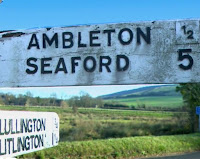 By Dan Parkes (Director)
By Dan Parkes (Director)'Less is more' as they say and this can very true when it comes to visual effects. If you don't notice the effect, then it has served it's purpose. Ambleton Delight surprisingly contains many visual effects, from town name replacements and logo removals, to day-for-night shots, image stabilisation (to correct shaky dolly shots) and adding atmospheric elements such as smoke and rain. But there is only one obvious visual effect which is when a static picture in a newspaper transforms into an actual moving image that itself then transforms from day-to-night.
All the visual effects were completed using basic tools in Adobe After Effects. However, effects is not primarily about the software. The key to an effective effects workflow is to work backwards; firstly establish the desired end product in as much detail as possible (even storyboarding it) and then work out what elements and particular shots (maybe angles or durations) are required to achieve it.
Take a look at three basic effect shots we did and how they were done (click on the images for an enlarged version):

 1. Ambleton sign replacement
1. Ambleton sign replacementWe shot a master plate ensuring even lighting and no camera movement. The original letters from the Alfriston sign were then recreated to read Ambleton using primarily the clone tool in Photoshop. The new letters were then added to the shot in After Effects by motion tracking the image (as there is very subtle movement). Then the final shot is colour corrected -an important ingredient to 'selling' any shot that has elements from different sources. The village signs were so effective that many did not notice the difference...even the camera operator who shot it!
 2. Logo/graffiti removal
2. Logo/graffiti removal There are dozens of shots in the film that had logos removed for one reason or another. In this example, a very obvious 'Christmas '08' is written on the fence behind the action in a scene which is supposed to take place in the late 80s or early 90s. So it clearly had to go! In After Effects it was removed frame-by-frame by masking out areas and replacing the graffiti with a cloned part of the fence.
 3. Moving newspaper image
3. Moving newspaper imageIn this effect the lead actor opens a newspaper to an article and we then zoom in on the main picture of the restaurant which transforms into live action footage of a day-to-night time-lapse. This was accomplished by firstly filming a shot of the actor opening a real newspaper, inside of which we placed some green motion tracking markers. In After Effects we then tracked and replaced these with a digital article about the restaurant, complete with a headline, story and photographs. The main photograph is in a fact a freeze frame of time-lapse footage which in itself is a day for night effect shot.
For more information on the day-for-night technique, please refer to this earlier blog.
There are some great places where you can find tutorials on using After Effects. Here are some of my favourites:
http://www.videocopilot.net/
http://ae.tutsplus.com/
http://greyscalegorilla.com/blog/





No comments:
Post a Comment